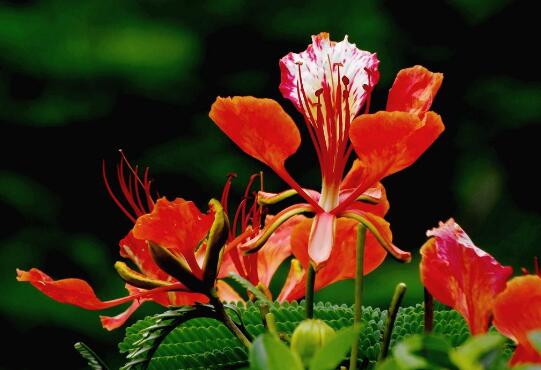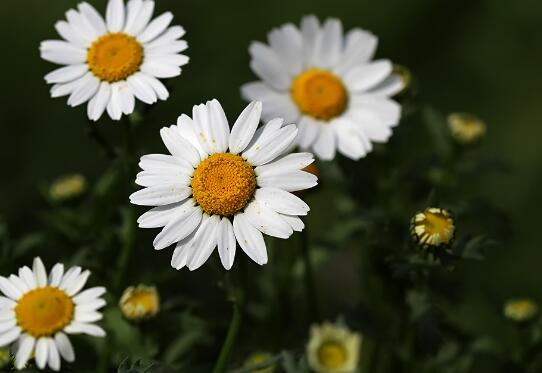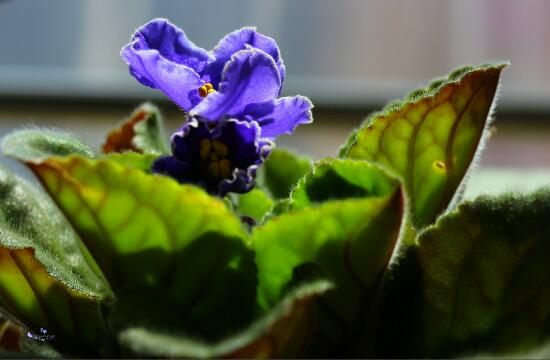How to raise Phoenix wood, the breeding methods and precautions / light should be sufficient.
Phoenix wood is also known as Phoenix wood, it is a leguminous plant, it can be seen in many parts of our country, but if we want to raise it well, there are many places we need to pay attention to, about how to raise Phoenix wood? What are the breeding methods and matters needing attention of Phoenix wood? Next, the editor will take you to learn about it.
First, how to raise Phoenix trees and understand their habits

If we want to know how to raise Phoenix wood, we must first understand its growth habits. This plant likes to grow in a warm and humid environment and likes light, so we should keep it in sufficient light when we breed it. In addition, daily water and fertilizer management is also what we should pay attention to. Details are below, let's take a look.
II. Culture methods and matters needing attention of Phoenix wood
1. Sandy loam
Before we cultivate Phoenix wood, we should first choose soil, which is a step to lay a good foundation and is very important. generally, it is best to choose loose, fertile and organic matter-rich sandy loam, which has good drainage and air permeability. can let the plant better absorb nutrients, but also not easy to appear the phenomenon of stagnant water.
two。 Temperature, 20: 30 ℃
When we cultivate Phoenix wood, the management of temperature is also very important. Only if we let it grow at a suitable temperature, it can grow better. The suitable growth temperature of Phoenix wood is between 20 and 30 ℃, which is not cold-resistant, and it is not conducive to its growth if the growth temperature is lower than 10 ℃.
3. Fertilizing, applying base fertilizer before planting
Fertilizer is one of the main nutrients in the growth process of Phoenix wood, so fertilization is an essential link in the process of cultivating it. First of all, when planting it, we should apply appropriate amount of base fertilizer to the soil. Before flowering and after entering the flowering stage, we also need to apply phosphorus and potassium fertilizer, which can make the flowers bloom more brightly.
4. Moisture, avoid stagnant water
Phoenix wood this kind of plant likes to grow in a warm and humid environment, so when we cultivate it, we should water it frequently and keep the soil moist, so that the plant can thrive. When there is not enough watering, there is one thing we should pay attention to. This kind of plant is not resistant to stagnant water, so we should pay attention to control the amount of water, if stagnant water can easily cause its roots to rot.
5. Light, avoid strong light
Phoenix wood is a kind of light-loving plant, when the light is more suitable in spring and autumn, we can put it outside to receive light throughout the day, but in summer, because the light is relatively strong, so we still need to pay attention to shade, so as not to burn the plant.
6. Timely treatment of diseases and insect pests
When we cultivate Phoenix trees, if we are not careful enough, diseases and insect pests will easily occur, and this kind of problems are very harmful to plants, so we must deal with them in time when they are found. for specific treatment methods, you can refer to the article on pest control of Phoenix wood, in which there is detailed teaching.
How to raise Brazilian wood _ maintenance method of Brazilian wood
Brazilian wood, also known as Brazilian iron tree, Brazilian millennium wood, Phnom Penh fragrant dragon blood tree, is a kind of dragon blood tree of Liliaceae, and its scientific name is Xianglong academy, which is also an evergreen tree plant of Liliaceae. It is a very famous indoor foliage plant, the general height is more than 6m, while the height of the pot plant in 50cm-150cm, there are branches, leaf clusters born at the top of the stem, the length is 40-90cm, the width is 6-10cm, is curved and arched, the leaves are bright green and shiny. Although its flowers are inconspicuous, but with a touch of fragrance, the plant shape is very beautiful, neat, very popular indoor foliage. So many people want to know the maintenance method of Brazilian wood, the following editor will introduce to you how to raise Brazilian wood, has been the maintenance method of Brazilian wood. [growth habits of Brazilian wood] Brazilian wood likes to grow in a hot and humid climate, and its light adaptability is very strong, and it can grow normally in slightly shaded sunlight. Photosynthesis should be carried out in spring, autumn and winter, and proper shade or indoor ventilation should be maintained in summer. The vitality of Brazilian wood is very strong, only in the case of sunshine, air and a little water, it can grow very well by relying on its own potential energy, it is resistant to drought and waterlogging, and should be fully watered during the growing period. Brazilian wood is afraid of cold. It can grow normally when kept indoors or in sunny places in winter. The temperature should be between 5 and 10 degrees Celsius. It originates in West Africa and is distributed in Yunnan, Hainan, Guangxi, Thailand, Cambodia, Indonesia, America and other places in China. [how to raise Brazilian wood] the propagation methods of Brazilian wood include cutting method and water culture method, which are usually carried out from May to August. If the Brazilian wood planted for many years is too large, the leaves under the stem will fall off, which will reduce the value of the process. The stalk around 10cm can be cut in the basin and then used as cuttings. Place the rough sun or vermiculite in a flowerpot or bucket to make a slotting bed, and then insert the insert into it. To often spray water to maintain the humidity of the bed, the temperature at 21-24 degrees Celsius is very conducive to Brazilian wood cuttings sprouting, generally in 3-4 weeks can take root into a pot. [Brazilian wood conservation method] the first step: temperature and light in the maintenance method of Brazilian wood must pay attention to temperature and light, the temperature is generally 20-28 degrees Celsius, if the temperature is less than 13 degrees Celsius, Brazilian wood will enter a dormant state, the temperature is less than 5 degrees Celsius, the leaf tip and edge of Brazilian wood will appear chloasma, or even death. If the Brazilian wood is maintained indoors, it should be placed in a sunlit place.
The second step: moisture and humidity Brazilian wood maintenance methods must pay attention to moisture and humidity, Brazilian wood in the growth of moisture requirements are not much, but there are some requirements for humidity. We should maintain the wettability of the basin soil during maintenance, and we can often spray water on the leaves so as to improve the humidity of the air. But do not let water accumulate in the basin soil, otherwise there will be rotting roots.
The third step: soil and fertilizer Brazilian wood conservation methods must pay attention to soil and fertilizer, Brazilian wood is suitable for growing in loose and fertile river sand soil, in the process of conservation, the basin needs to be changed once a year to keep the soil with sufficient nutrients. During the growing period, Brazilian wood can apply organic fertilizer at the base or edge, and apply liquid fertilizer every half a month, thus keeping the branches and leaves of Brazilian wood growing more luxuriantly.
Step 4: in the conservation methods of Brazilian wood to prevent insect pests, attention must be paid to the prevention of insect pests. Some leaves will be scorched due to mess, low temperature, excessive amount of water and improper fertilization during growth. We should improve the maintenance methods. To control the temperature and humidity and remove pests in time, you can spray some diluted pesticides. Conclusion: Brazilian wood is a kind of modern and popular indoor large potted flowers and trees, which generally appears in the spacious living room, study and living room, giving people a kind of elegant and simple strips, with some southern flavor inside. Its plant shape is very beautiful and regular, and it is a very famous new generation of indoor foliage plants in the world. The above is the editor for you to introduce how to raise Brazilian wood, as well as the maintenance methods of Brazilian wood. I hope you can learn the maintenance method of its Brazilian wood, so that you can live in an elegant and clean environment every day. Thank you for your appreciation.
More information about Bletilla striata pictures what are the varieties of hypericum, Phoenix wood pictures, night flowers how to plant buttercup pictures
What is the effect and function of the blue flower mackerel?
Dioscorea nipponensis is a plant of the genus Artemisia of the family Liriodendron. Distributed in Argentina, Bolivia, Brazil and China's Guangxi, Hainan, Guangdong, Yunnan, Fujian and other places, the crown is high, 13-14 meters high, up to 20 meters. Leaves are bipinnately compound, large, with more than 16 pairs of pinnae, each pinnate with 10-24 pairs of leaflets, pinnate, closely inserted; quite beautiful, leaflets about 6 mm long. Panicles, apical or axillary; flowers campanulate, 25-35 cm long; lavender, flowering in late spring and early summer. Fruit a capsule, orbicular slightly flattened, light brown, ca. 5 cm in diam. The leaves fall when they blossom. The tree is nicknamed for its fern-like leaves; also known as the blue fog tree, the wood is dark brown.
The culture method of blue flower mackerel
1. Temperature and light
Blue flower is native to tropical America. It likes warm, humid, sunny environment and is not resistant to frost and snow. The suitable growth temperature is 22 to 30 ℃. If the winter temperature is lower than 15 ℃, the growth will stagnate. If it is lower than 3 to 5 ℃, it will cause chilling injury. If the summer temperature is higher than 32 ℃, the growth will also be inhibited. If you like the light, you can withstand the half-yin.
2. Soil and fertilization
For the fertile and moist sandy loam or loam, sufficient basal fertilizer should be applied when planting, topdressing once in spring and autumn after survival, pruning once in early spring every year, and heavy pruning should be applied to aging plants. When potted, it can be dried or grafted and dwarfed, and watering and nitrogen fertilizer can be controlled.
3. Pest control
The disease of blue flower is less, and the insect pests are mainly longicorn beetles. if reddish-brown dung shavings are found at the base of the trunk, a knife can be used to pick up the bark cortex to catch larvae; before the occurrence of adults, a mixture of 10 parts of quicklime, 1 part of sulfur and salt can be applied below 80 cm of the trunk to prevent adults from spawning.
The Propagation method of Scutellaria paniculata
Sowing and reproduction
The ripening period of the capsule is November, which is exposed or stacked in a windless place after harvest, dried and stored until March of the following year. The seeds are sown when the temperature is around 20 ℃, but the seed germination rate is only about 5%.
Cuttage propagation
It can be carried out in both spring and autumn, and the medium-ripe branches are selected as cuttings with high rooting rate.
Tissue culture
Some scientific research institutions in China have used the stem top and stem segments of seedlings as explants to propagate a large number of test-tube plantlets.
The efficacy and function of Blue Flowers
1. The ornamental value of the blue flower.
The blue flower is a tall deciduous tree with a maximum height of 15 meters. Its leaves are opposite and oval in shape. The calyx of the blue flower is slender, mostly blue, and the filaments grow on the middle part of the calyx. The blue flower bears woody fruit, and the florescence is usually between May and June. The leaves and flowers of the blue flower are beautiful, which is the main reason why it is an ornamental plant.
2. Blue flower can be used in garden construction.
Blue vetch is a characteristic tree species that can observe both leaves and flowers. it grows in tropical and subtropical areas and can be used as street trees and scenic trees. it is the most common ornamental tree species in various scenic spots in the south. It blossoms once a year in summer and autumn. when the flowers are in full bloom, the purple-blue flowers are particularly attractive and the fragrance of the flowers can float far away.
3. The economic function of the blue flower.
Blue flower is a kind of economic tree species with high economic value. its wood can be used for papermaking and can create high economic value. in addition, the wood of blue flower is yellow and white wood with lighter texture and straight texture is the ideal material for making furniture. and the blue flower is not easy to deform after being processed into furniture, and it has been preserved for a long time, so it is very popular in the furniture market.
What is the fancy language of Blue Flower Cow?
The flower language of Blue Flower: stands for serenity, far-reaching, hesitation, waiting for love in despair. It is also called "double Shadow" with Phoenix trees full of red flowers (Red Shadow Tree refers to Phoenix Tree, Blue Shadow Tree means Flower).
- Prev

How to grow white chrysanthemum? the planting method / survival rate of white crystal chrysanthemum is as high as 90%.
Among the breeding methods of white chrysanthemum, sowing is the main method. This method has been tested by countless people, but it still has a high survival rate. However, if we want to sow successfully, there are many points we need to pay attention to. How to grow white chrysanthemum? What is the planting method of white chrysanthemum?
- Next

How to raise African violets, the culture methods and matters needing attention of African violets
African Violet, friends who have seen it should be impressed. It is small and exquisite in shape and colorful, and it is very ornamental when raised indoors. In life, because African violets are good-looking, many people want to keep them. How to raise African violets?
Related
- Fuxing push coffee new agricultural production and marketing class: lack of small-scale processing plants
- Jujube rice field leisure farm deep ploughing Yilan for five years to create a space for organic food and play
- Nongyu Farm-A trial of organic papaya for brave women with advanced technology
- Four points for attention in the prevention and control of diseases and insect pests of edible fungi
- How to add nutrient solution to Edible Fungi
- Is there any good way to control edible fungus mites?
- Open Inoculation Technology of Edible Fungi
- Is there any clever way to use fertilizer for edible fungus in winter?
- What agents are used to kill the pathogens of edible fungi in the mushroom shed?
- Rapid drying of Edible Fungi

